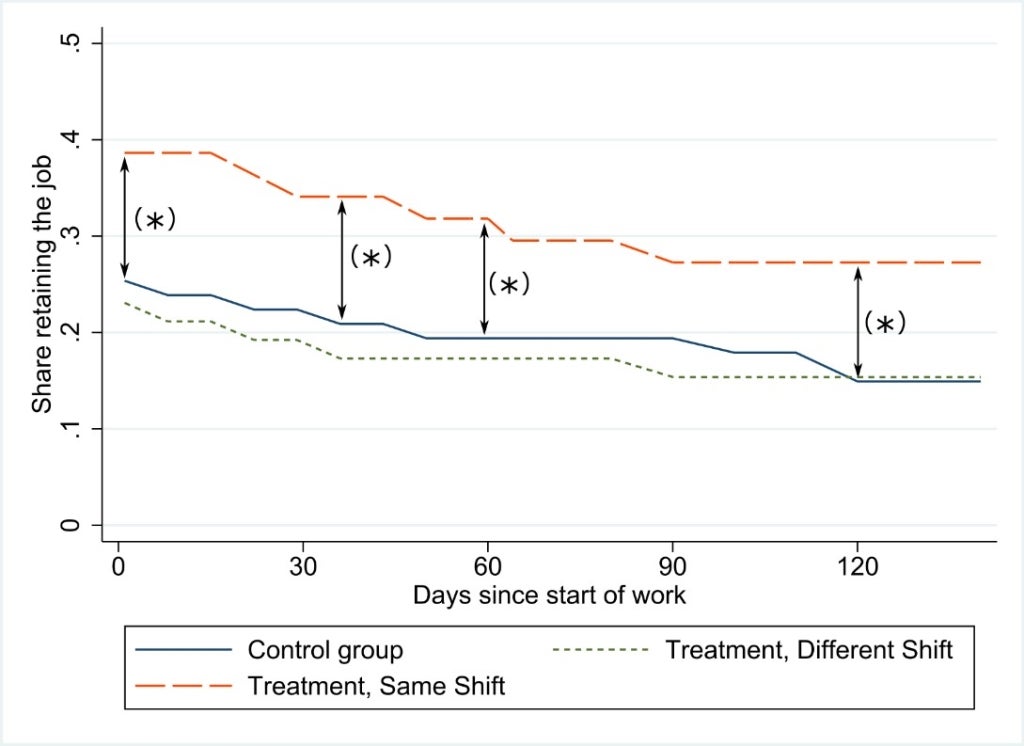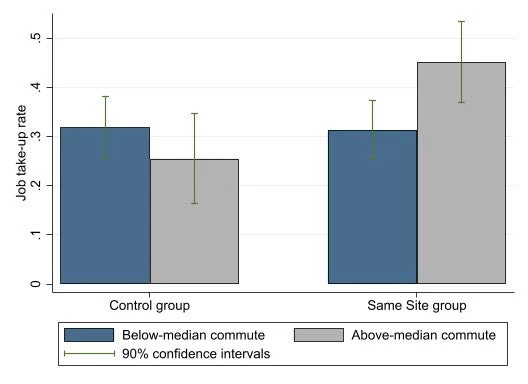This is the sixth in this year’s series of posts by PhD students on the job market
When you talk about jobs with any worker or HR manager in a lower-income country, the conversation inevitably turns to the importance of whom you know. Workers often share information about job opportunities at their firm with friends, firms solicit referrals from their workers when filling vacancies, and job seekers rely heavily on networks for their job search. These patterns have been documented across a wide range of occupations, sectors, and countries. But do individuals actually value working with people they know? How much, and why? And what are the implications for policy design, including active labor market interventions in lower-income countries?
We examine these questions in my job market paper, co-authored with Aletheia Donald, through two field experiments in Abidjan, Côte d’Ivoire. Our primary goal is to test whether individuals’ decisions to work at a given firm depend on whether others from their social circle also work at the firm—that is, whether complementarities in labor supply exist. If they do, it could help explain key stylized facts about firms’ behavior and labor market outcomes—including the job search patterns mentioned above and the presence of persistent gaps in employment across ethnic groups and gender in lower-income countries.
Our secondary goal is to understand what may be driving such complementarities. We focus on one specific channel that is especially relevant in urban labor markets of lower-income countries: commuting costs. Commuting to work is usually long, tedious, and often unsafe, due to poor urban planning, a lack of adequate transportation infrastructure, and congestion. Commuting times average over an hour per day across lower-income countries, time that could have been devoted to valuable activities such as leisure, work, or sleep. Commuting thus represents a major factor, besides wages, that determines work decisions. Given this, the ability to commute with friends could serve as an important benefit that offsets the costs from commuting. We thus design our experiments to not only directly test whether complementarities in labor supply exist, but also to identify the role that commuting costs play (while also providing evidence on alternative potential mechanisms).
In both our experiments, we ask job seekers receiving a job offer whether they want to refer people they know for similar jobs at the same firm. We then randomly vary whether the referred individuals end up actually receiving a job offer, as well as whether that job would entail working at the same time and location as the initial job seeker who referred them. We also induce random variation in commuting time across job seekers by varying the prospective job location.
Impacts on job take-up and retention for factory jobs
We run our first experiment in partnership with a large multinational company operating a cashew-processing plant. We offer factory jobs (which are long-term jobs with no end date specified in the contract) to 163 job seekers. Most of them are women, 29 years old on average, and about two thirds have a low-paying income-generating activity at baseline. Before they start working at the plant, we elicit referrals for openings at the same plant. Most of the individuals they refer live in the same neighborhood, allowing for joint commuting to work.
Work at the plant is organized into non-overlapping shifts. We leverage this job feature by randomly assigning job seekers to one of three groups:
- “Control” (the individuals they refer do not receive an offer),
- “Same Shift” (up to three individuals they refer receive an offer, to work in the same shift as them), and
- “Different Shift” (up to three individuals they refer receive an offer, to work in the different shift).
We use administrative records from the firm to measure job take-up and retention for all individuals involved in the experiment.
Figure 1: Factory jobs take-up and retention, by treatment arm

Among the job seekers who receive an offer alone (the Control group), only 25% show up to work at least once. Among them, 41% leave the factory within four months. These patterns reflect the hiring and retention difficulties reported by our partner firms, also broadly documented across lower-income countries.
In contrast, job seekers whose network members were also offered a job take up and retain their jobs at much larger rates–but only when they’re assigned to work in the same shift. Their job take-up increases by 16 percentage points, a 63% increase from the take-up rate in Control (statistically significant at the 10% level). This effect is sustained over time: the share of job seekers at the factory remains 10-18 percentage points higher in the Same Shift group than in the Control group even four months later, at the end of data collection. Meanwhile, there is no significant difference in job take-up or retention rates between the Control and Different Shift groups. This tells us that the ability to interact–whether on the job or during their commute–is a necessary condition to explain our effects.
In addition, while our sample is small for looking at heterogeneity, we find suggestive evidence that the Same Shift effects are coming from workers with long commutes, rather than from job seekers who live close to the factory. We also find that when we look at the behavior of 760 other factory workers outside of our experiment, their attendance and turnover can be predicted by the attendance and quits of the factory workers with whom they commute to work. We can rule out that correlated shocks fully drive these effects and instead find evidence for coordination in work decisions among co-commuting peers.
Impacts on job take-up and productivity for sales jobs
We run our second field experiment to causally test whether the ability to commute together is what’s driving the observed labor complementarities.
This time, we work with a marketing firm offering 873 short-term street canvassing jobs across two worksites in Abidjan. They are on average 25 years old and university-educated, and 37% of them are women. We again randomize whether individuals they refer are also offered a job on the same campaign, and also vary whether they would be working at the same worksite. We further randomize to which worksite each job seeker is assigned—inducing random variation in commute times. The median commute time to the assigned worksite is 2 hours, with the 25th and 75th percentiles at 1 and 3 hours respectively.
Figure 2: Take-up of the sales jobs, by commuting time and ability to commute together
We find that job seekers are 7 percentage points more likely to take up the offered job when the individuals they refer are also offered a job to work at the same worksite. This represents a 20% increase over the control group’s 34% take-up rate, and does not come at the expense of productivity. In contrast, when the individuals they refer are offered a job at a different worksite—reducing the potential co-commute length—we observe a statistically insignificant 4 percentage points effect on job take-up. The take-up effects are stronger for job seekers with randomly-induced longer commutes, but only when assigned to work at the same worksite. Further, job seekers with below-median commuting time have virtually no response. Taken together, our results suggest that commuting together is the primary mechanism through which the employment of network members influences individuals’ labor supply.
Implications for active labor market interventions
Across the two experiments, we find that job seekers are much more likely to accept a job if they are hired together with network members and can commute together. This implies that individuals may decline jobs if they don’t know others at the firm with whom they could commute, resulting in a low-employment equilibrium. Such equilibria could help explain the limited long-term success of active labor market interventions and indicate that targeting these interventions to networks rather than individuals may make them more effective.
Moreover, qualitative interviews we conducted with job seekers suggest that sharing the pecuniary cost of transport is not the reason why they value co-commuting: the most common transport options charge a fixed price per head. Rather, our results indicate that making commuting shorter, more pleasant and/or safer (in particular for women job seekers, who reported safety as a key benefit of co-commuting) are more promising avenues for increasing employment in lower-income country cities.
Florian Grosset is a PhD student at Columbia University.



Join the Conversation